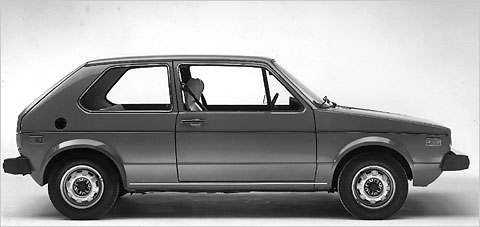The Volkswagen Rabbit History
Small and cheaper yes it’s the concept for true VW Rabbit… wrong…
This real basic why Volkswagen was create the Rabbit…
1975, 35 years ago Volkswagen create a little car to confront the Japanese cars attack that penetrates the U.S. market with little econoboxes far cheaper than a Beetle. So Japanese little cars it’s a main cause of VW sales dropping in U.S. market.
The VW Rabbit was the replacement for the Beetle in the US market.
VW Rabbit is the next generation of Volkswagens car, before all production cars using the rear engine and rear-wheel drive technology. VW Rabbit at first it was offered as front wheel drive car with a water-cooled 4 cylinder, manual and automatic transmission, carburetor for the fuel system, that was frugal in every way, for around the same price as a Japanese little car (econobox).
1975 – 1976 for the first two years of productions ’75 and ’76 VW Rabbit have many drivability problems. There were many recalls, and updates, but basicly the system was flawed and unable to overcome the added smog equipment the US market required. So If you can find a ’75 or ’76 the Rabbit can running well on the road today, almost certainly it’s a miracle.
1977 they introduced the Bosch C.I.S fuel injection system and saved the Rabbit from a miserable life. So if you want to buy classic VW Rabbit today, consider a Rabbit made between ’77 to 80 to be a great find.
The Rabbit sales began to climb as the gas crisis of the late 70’s took hold.
The Rabbit had finally become the worthy successor to the Bug (Beatle) on around 1979, when the oil crisis was at full force. In 1979 the Rabbit got even thriftier with the introduction of a diesel motor that got almost 60 miles to the gallon on the highway.
Production for the U.S. market moved over here to New Stanton Pennsylvania in 1978. The first Rabbit rolled of the assembly line on April 10th 1978 with NBC news present to unveil the first foreign car to be built in the USA.
1979 VW Rabbit became very popular, and still hold their resale value. The Rabbit had waiting lists at the dealership during that time. Also 1979 was the first year Rabbits were made in USA. The factory made all the USA bound 2dr and 4dr rabbits until 1984.
1980 Was a Big Rabbit comes out. This year the Rabbit’s Engine grew to 1.6L and with the CIS system it started to put out a lot of Power. Volkswagen also introduced the Rabbit Pickup, and from europe came the convertible Rabbit. All this added up to big rabbit sales.
1981 more bigger, the gas engine grew from 1.6 to 1.7l , and the diesel now a 1.6 up from 1.5.
1982 the GTi was introduced, a sporty version of the Rabbit. The GTi came with a 1.8l engine, stiffer suspension, alloy wheels, front air dam, and special Recaro sport seats. Top speed, acceleration, and handling were improved on the GTi. Also in this year, the luxurious Rabbit from Germany, Wolfsburg Edition Rabbit came along, that came with a special interior, A/C, an extra moulding on the bottom of the door, and little odds and ends.
1984 game is over, it’s last year for the Rabbit, on July the Rabbit moved over to make way for the production of the new Golf.
Backbone of Golf …
VW Rabbit never received many changes over the time of production, but it did receive many improvements.
The Rabbit, although short lived, gave a new start for Volkswagen. The Rabbit is still sought after all over the U.S., it just goes to show you a good Volkswagen never dies.
On April 12 2006 at the Detroit Auto Show Volkswagen of America was announced the come back of the Rabbit. This new model Rabbit is the same model as the Golf V being sold in the rest of the world. VW was hoping the nostalgia-factor coupled with a lower price tag will help boost Rabbit sales.
2008 October with rising manufacturing costs and a new MK VI chassis design on the way, production of the MK V Rabbit ceased. The 2009 model would be the last vehicle available under the VW Rabbit branding.
